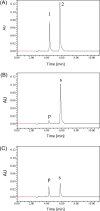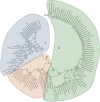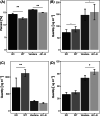A drought-responsive rice amidohydrolase is the elusive plant guanine deaminase with the potential to modulate the epigenome
- PMID: 33749847
- PMCID: PMC8360030
- DOI: 10.1111/ppl.13392
A drought-responsive rice amidohydrolase is the elusive plant guanine deaminase with the potential to modulate the epigenome
Abstract
Drought stress in plants causes differential expression of numerous genes. One of these differentially expressed genes in rice is a specific amidohydrolase. We characterized this amidohydrolase gene on the rice chromosome 12 as the first plant guanine deaminase (OsGDA1). The biochemical activity of GDA is known from tea and coffee plants where its catalytic product, xanthine, is the precursor for theine and caffeine. However, no plant gene that is coding for GDA is known so far. Recombinant OsGDA1 converted guanine to xanthine in vitro. Measurement of guanine and xanthine contents in the OsGDA1 knockout (KO) line and in the wild type Tainung 67 rice plants also suggested GDA activity in vivo. The content of cellular xanthine is important because of its catabolic products allantoin, ureides, and urea which play roles in water and nitrogen stress tolerance among others. The identification of OsGDA1 fills a critical gap in the S-adenosyl-methionine (SAM) to xanthine pathway. SAM is converted to S-adenosyl-homocysteine (SAH) and finally to xanthine. SAH is a potent inhibitor of DNA methyltransferases, the reduction of which leads to increased DNA methylation and gene silencing in Arabidopsis. We report that the OsGDA1 KO line exhibited a decrease in SAM, SAH and adenosine and an increase in rice genome methylation. The OsGDA1 protein phylogeny combined with mutational protein destabilization analysis suggested artificial selection for null mutants, which could affect genome methylation as in the KO line. Limited information on genes that may affect epigenetics indirectly requires deeper insights into such a role and effect of purine catabolism and related genetic networks.
© 2021 The Authors. Physiologia Plantarum published by John Wiley & Sons Ltd on behalf of Scandinavian Plant Physiology Society.
Figures




References
-
- Abeles, R.H., Fish, S. & Lapinskas, B. (1982) S‐Adenosylhomocysteinase: Mechanism of inactivation by 2′‐deoxyadenosine and interaction with other nucleosides. Biochemistry, 2, 5557–5562. - PubMed
-
- Allen, G.C., Flores‐Vergara, M.A., Krasynanski, S., Kumar, S. & Thompson, W.F. (2006) A modified protocol for rapid DNA isolation from plant tissues using cetyltrimethylammonium bromide. Nature Protocols, 1, 2320–2325. - PubMed
-
- Anoosha, P., Sakthivel, R. & Gromiha, M.M. (2015) Prediction of protein disorder on amino acid substitutions. Analytical Biochemistry, 491, 18–22. - PubMed
-
- Ashihara, H., Sano, H. & Crozier, A. (2008) Caffeine and related purine alkaloids: Biosynthesis, catabolism, function and genetic engineering. Phytochemistry, 69(2008), 841–856. - PubMed
MeSH terms
Substances
Grants and funding
LinkOut - more resources
Full Text Sources
Other Literature Sources
Research Materials
Miscellaneous

